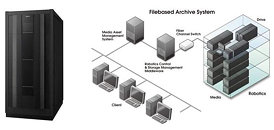Monday, April 16th 2012

Sony Helping Create New Mass-Storage Optical Disc Archive Solutions
Sony Corporation today announced that it will be commercializing a next-generation optical disc archive storage system. Sony will also organize an Optical Disc Archive Advisory Group to promote the adoption of this new storage format among the various companies in related industries.
Sony's new system will deliver superior long-term storage capabilities, which are enabled through the use of media built to withstand changes in temperature and humidity, and is dust and water resistance. Furthermore, the new system provides guaranteed intergenerational compatibility and eliminates the need to re-archive copies of past archive data, offering a more user-friendly and dependable long-term storage solution.By Fall 2012, Sony will be releasing various optical disc media for archive storage solutions into the market that is compatible with the "ODS-D55U" drive unit equipped with a USB 3.0 interface and storage capacities between 300 GB-1.5 TB (model name: ODC1500R etc.) Sony plans to consecutively enhance its product lineup upon this initial release.
Additionally, Sony has organized Optical Disc Archive Advisory Group open to participation by media and entertainment companies from across the globe to further build the market for video image archive solutions.
With this group, Sony will collaborate with partners to establish and maintain a solution and application software environment that advances optimum specifications and system architectures among other areas, while anticipating future trends and demand in the archive solutions segment. The broadcasters and motion picture companies listed below have already announced their participation in the Optical Disc Archive Advisory Group.
This collaboration will consider and study the potential for utilization of optical disc media in their archive workflow and develop appropriate application software for future media asset management and distribution strategies. Workshops and pilot projects will start to support these mutual activities, targeted for product shipment timing of Fall 2012.
Furthermore, in addition to the production of media and drive units, Sony will collaborate with a variety of other manufacturers in related business areas such as storage media, robotics (automated media exchange systems), middleware (hierarchical storage management and control) and application software for media asset management (including media management and search) for the purpose of developing system solutions for media archive applications.The following manufacturers who have already expressed their support for the Optical Disc Archive:
- ASG-Atempo, Dalet, Front Porch Digital, Harris, SGL, Square Box Systems Ltd, TDK Corporation, Vizrt
Specifically, TDK Corporation has announced both its full support of the Optical Disc Archive and that it will begin manufacturing disc media under license from Sony.
In addition to the commercialization of various products, Sony will continue to promote its efforts through Optical Disc Archive Advisory Group activities. The establishment of an open platform so that the valuable video content stored in tape media can be archived and passed on to the next generation in an optimal format will help industry move toward creating a new market for archive solutions.
Sony's new system will deliver superior long-term storage capabilities, which are enabled through the use of media built to withstand changes in temperature and humidity, and is dust and water resistance. Furthermore, the new system provides guaranteed intergenerational compatibility and eliminates the need to re-archive copies of past archive data, offering a more user-friendly and dependable long-term storage solution.By Fall 2012, Sony will be releasing various optical disc media for archive storage solutions into the market that is compatible with the "ODS-D55U" drive unit equipped with a USB 3.0 interface and storage capacities between 300 GB-1.5 TB (model name: ODC1500R etc.) Sony plans to consecutively enhance its product lineup upon this initial release.
Additionally, Sony has organized Optical Disc Archive Advisory Group open to participation by media and entertainment companies from across the globe to further build the market for video image archive solutions.
With this group, Sony will collaborate with partners to establish and maintain a solution and application software environment that advances optimum specifications and system architectures among other areas, while anticipating future trends and demand in the archive solutions segment. The broadcasters and motion picture companies listed below have already announced their participation in the Optical Disc Archive Advisory Group.
This collaboration will consider and study the potential for utilization of optical disc media in their archive workflow and develop appropriate application software for future media asset management and distribution strategies. Workshops and pilot projects will start to support these mutual activities, targeted for product shipment timing of Fall 2012.
Furthermore, in addition to the production of media and drive units, Sony will collaborate with a variety of other manufacturers in related business areas such as storage media, robotics (automated media exchange systems), middleware (hierarchical storage management and control) and application software for media asset management (including media management and search) for the purpose of developing system solutions for media archive applications.The following manufacturers who have already expressed their support for the Optical Disc Archive:
- ASG-Atempo, Dalet, Front Porch Digital, Harris, SGL, Square Box Systems Ltd, TDK Corporation, Vizrt
Specifically, TDK Corporation has announced both its full support of the Optical Disc Archive and that it will begin manufacturing disc media under license from Sony.
In addition to the commercialization of various products, Sony will continue to promote its efforts through Optical Disc Archive Advisory Group activities. The establishment of an open platform so that the valuable video content stored in tape media can be archived and passed on to the next generation in an optimal format will help industry move toward creating a new market for archive solutions.


34 Comments on Sony Helping Create New Mass-Storage Optical Disc Archive Solutions
I see it as the first public step in that innovation the new sony ceo was talking about
Since they failed with DAT for backup(as it stagnated in capacity and performance and it's utterly unreliable -and this i tell you by experience, i've never seen a DAT drive survive a decent ammount of time or a DAT tape not developing critical errors-) this looks like simply one of those experimental ultra high capacity dual-side-dual layer blurays into a cartridge(propietray sony ofc) which means they can sell it for 5x the true cost.
@munchroom: there's nothing faster than tape nowadays(for backup, i.e.: streaming), optical is at least 2+ gens behind tape atm in performance.
Optical will hardly do more than 30~40MB/s, LTO-5 does 140MB/s UNCOMPRESSED and 280MB/s compressed(not to mention it has 1.5TB capacity native to 3TB compressed).
Also, you can see this is not a "serious" solution as it uses USB 3.0 because servers don't have USB 3.0 onboard(not even current gen ones) and there aren't direct options available from manufacturers(i.e: IBM nor HP nor Dell have server-certified USB 3.0 HBAs) which means companies will be very weary to adopt it.
And whilst USB 3.0 optimistically can reach 400MB/s, i rather connect my backup drives with a guaranteed BW SAS 6Gbps link that was designed for storage rather than a consumer-thought interface. And you can see this in LTO drive design, it's either 3G-SAS, 6G-SAS or FC
It was possible in 2004 just due to the size of the average server, with the increase in storage, and the not so big increase in optical writing speeds, its just not practical anymore.
EDIT: The fastest DVDs are 24x or 253.44 Mbit/s, on a Gigabit network, that becomes a massive bottleneck. Unless they write multiples at once.
Bluray is double that.
Interesting that they are going to use OD as the medium to go forward rather than your traditional tape, but the inertia to adopt it will most likely knee this little project before it can even learn how to walk.
That's the only way optical storage has a future
also anything that is not open standard for storage is going to fail in the marketplace
But i have never seen a failed LTO cartridge(other than mechanical failure induced by the drive itself, like missing the leader or tangling), THAT'S the reliability needed
New M-DISC to Provide Up To 1,000 Years of Permanent Data Storage
That would solve the reliability problem.
anyway, even if optical is used for archival over something else it should be used as a backup of the archive on a hdd array. (so as a second backup.) and still there is the point that this is sony we are talking about. they will create some BS proprietary nonsense that somebody can do twice as good for half the money :laugh:
Archival storage is for data that is not being accessed with any regularity or perhaps not at all unless there is some need to get historical references to something. Many times access to archival data is based upon a request for access (at which time the archive can be pulled and put online) and not on an immediate need.
Some IT departments will keep a portion of their archives online(or at least readily available) based upon the likelyhood of access need, and simply pull obsolete or unused data by request only.
Anyway, for small and medium sized businesses (and even some large businesses), not running HDD arrays can reduce overhead and replacement costs by utilizing other archival mediums (tapes, ODs), when high data availability and high access performance is not imperative.
As far as Sony using a propretary format that only works with there stuff, that's almost a given. But proprietary does not equal fail if there is a genuine market need (or desire) for this type of format.
As always, time and the markets will determine this projects success or failure.
All in all, it really depends upon your needs, your budget and how automated you want the access to archival data.